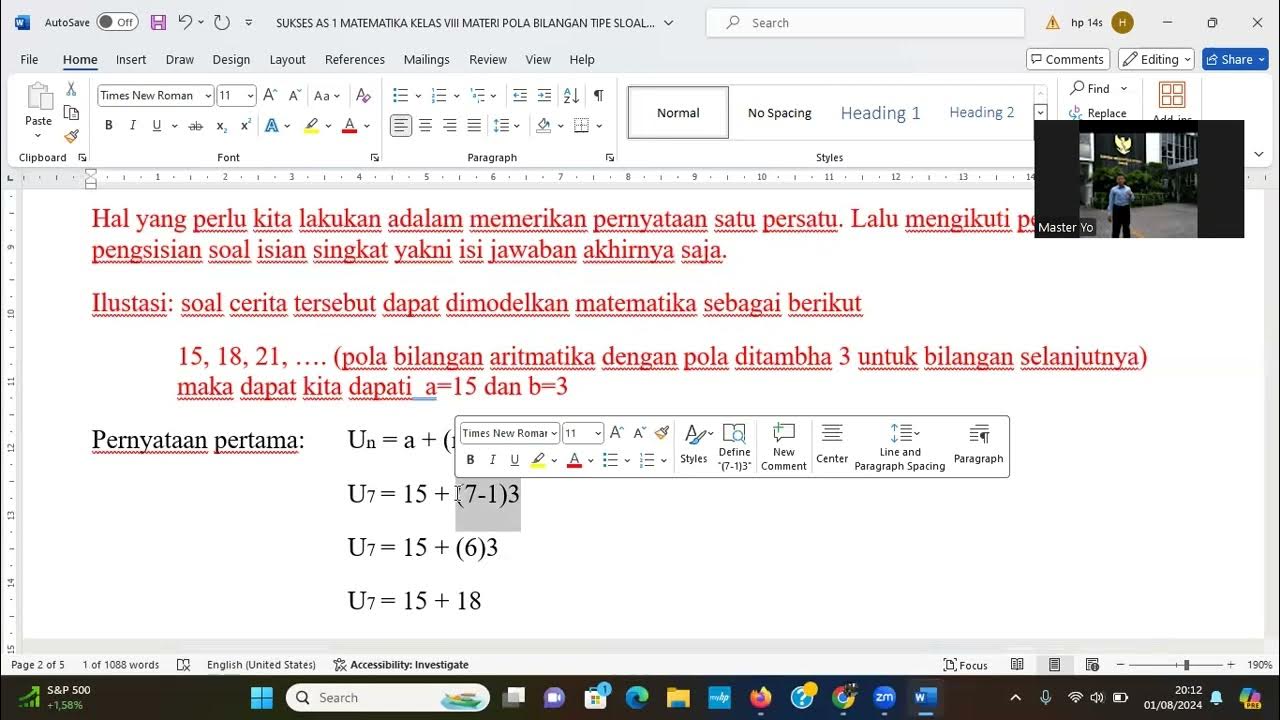KOMBINASI Peluang Mudah Banget
Summary
TLDRIn this educational video, the instructor explains quick tricks for solving combination problems in mathematics. Using real-life examples, they demonstrate how to calculate the number of possible combinations when selecting groups from a set. The problems cover scenarios such as choosing 3 representatives from 8 students, calculating handshakes among 10 people, and forming a basketball team from 12 athletes. The video simplifies the process with clear explanations, making it easy for viewers to grasp the concept of combinations and apply it to solve related problems efficiently.
Please replace the link and try again.
Q & A
What is the basic concept behind combinations in mathematics?
-Combinations refer to the selection of items from a larger set where the order does not matter. It is used to determine how many different groups can be formed from a given number of items.
How do combinations differ from permutations?
-The key difference is that in combinations, the order of selection does not matter, while in permutations, the order is important.
What formula is used to calculate combinations?
-The formula for combinations is: C(n, r) = n! / (r!(n - r)!), where 'n' is the total number of items and 'r' is the number of items to be selected.
How do you solve the first example problem about selecting 3 students from 8?
-To solve, use the combination formula: C(8, 3) = 8! / (3!(8 - 3)!) = (8 × 7 × 6) / (3 × 2 × 1) = 56. So, the number of ways to select 3 students from 8 is 56.
Why does the order of selection not matter in the first problem?
-In the first problem, selecting 3 students for a competition does not depend on the order in which they are chosen. The selection is simply about the group of students, not the sequence of their selection.
What is the logic behind the second problem about handshakes among 10 people?
-The problem asks how many distinct handshakes can occur among 10 people, where each handshake involves 2 people. This is a combination problem because the order in which the two people are chosen does not matter. The solution is C(10, 2) = 10! / (2!(10 - 2)!) = (10 × 9) / (2 × 1) = 45.
How do you simplify the combination formula during calculations?
-To simplify the combination formula, cancel out common factors between the numerator and the denominator. For example, in C(10, 2), the numerator is 10 × 9, and the denominator is 2 × 1. Simplifying gives 45.
Why is the second problem a combination problem and not a permutation problem?
-The second problem is a combination because the order of handshakes doesn't matter—only the pairs of people matter, not who shakes hands first or second.
How do you solve the third problem about selecting 5 players for a basketball team from 12 players?
-To solve, use the combination formula: C(12, 5) = 12! / (5!(12 - 5)!) = (12 × 11 × 10 × 9 × 8) / (5 × 4 × 3 × 2 × 1) = 792. So, the number of ways to form a team is 792.
What does 'order does not matter' mean in the context of the third problem?
-In the third problem, 'order does not matter' means that the 5 players selected for the basketball team do not need to be arranged in any particular order. The selection is about the group itself, not the sequence in which they were picked.
Outlines

This section is available to paid users only. Please upgrade to access this part.
Upgrade NowMindmap

This section is available to paid users only. Please upgrade to access this part.
Upgrade NowKeywords

This section is available to paid users only. Please upgrade to access this part.
Upgrade NowHighlights

This section is available to paid users only. Please upgrade to access this part.
Upgrade NowTranscripts

This section is available to paid users only. Please upgrade to access this part.
Upgrade NowBrowse More Related Video

Pembahasan Tes Kemampuan Akademik (TKA)|Kelas XII Matematika Wajib-1

Matematika SMA - Trigonometri (1) - Pengenalan Trigonometri, Perbandingan Trigonometri (A)

Latihan PAT Polinom/Suku Banyak ke (2) Matematika Peminatan XI MIPA Rosidawati Sinurat M.Pd

Propositional Logic | Conjunction, Disjunction & Negation | Discrete Mathematics | By Gp sir

Soal & Pembahasan SPTLDV Sistem Pertidaksamaan Linear Dua Variabel SOAL CERITA

Latihan Soal Pola Bilangan
5.0 / 5 (0 votes)